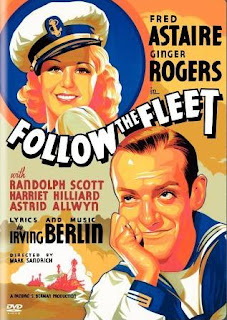Follow the Fleet/Swing Time
 Both of these Astaire/Rogers films are from 1936. Follow the Fleet is again directed by Mark Sandrich, but it makes some tactical errors in changing the pattern of the typical Fred and Ginger film. For one thing, Astaire, playing a sailor, is kept out of white tie and tails until the end of the picture. He's made to seem more like a regular Joe, smoking and chewing gum. It doesn't quite work--Fred Astaire was many things, but he wasn't an ordinary fellow. Perhaps more importantly, the sparkling troupe of character actors are gone. Instead of Edward Everett Horton, we get Randolph Scott, woefully miscast as the comic sidekick.
Both of these Astaire/Rogers films are from 1936. Follow the Fleet is again directed by Mark Sandrich, but it makes some tactical errors in changing the pattern of the typical Fred and Ginger film. For one thing, Astaire, playing a sailor, is kept out of white tie and tails until the end of the picture. He's made to seem more like a regular Joe, smoking and chewing gum. It doesn't quite work--Fred Astaire was many things, but he wasn't an ordinary fellow. Perhaps more importantly, the sparkling troupe of character actors are gone. Instead of Edward Everett Horton, we get Randolph Scott, woefully miscast as the comic sidekick.This time Fred and Ginger already know each other. He's in San Francisco on leave, and runs into her at a dime-a-dance club. They used to be partners in a dance act, but she turned down his proposal so he enlisted. She has a sister, a prim teacher (played by Harriet Hilliard, who would go on to greater fame as Ozzie's better half). She's attracted to Scott, but her librarian look leaves him cold, so Rogers gets her pals (one of them played by a platinum blonde Lucille Ball) to giver her a makeover. In the time-honored tradition, Scott sees her and all of a sudden is in love. But when Hilliard indicates she's interested in marriage he dumps her for a hot-to-trot divorcee.
The Scott-Hilliard plot really is the main one, and Fred and Ginger are window dressing. They have the usual dance routines, and there's some comedy (Fred accidentally puts bicarbonate of soda in Ginger's drink before a singing audition) but it all seems forced. If you happen to catch this on TV come back for the last ten minutes, when the two get into their evening finery to dance to Irving Berlin's "Let's Face the Music and Dance," which is a story in itself, with two people contemplating suicide finding meaning in terpsichory. Ginger wore a beaded dress that weighed thirty-five pounds, and in the first take (which is seen in the film) smacks Fred in the face with her sleeve. He said he saw stars.
Swing Time, which is perceived by some as the best Astaire/Rogers picture, was directed by George Stevens, one of America's great directors. In some respects it is the most accomplished of the films I've seen so far, but I don't think it measures up to Top Hat. Again, this has to do with what goes on between musical numbers.
In this film Astaire is Lucky Garnett, a small-time dancer and degenerate gambler (although the word degenerate is never used). He is late for his own wedding (to Betty Furness, who would go on to be a spokeswoman for Westinghouse in the early days of TV and then a consumer reporter) because he's caught up in gambling. He promises her father he'll go to New York and come back with a bankroll of $25,000 (a considerable sum in 1936, given the economic circumstances of the time). Along with his buddy, a magician played in a bizarre fashion by Victor Moore, Astaire heads to the big apple and meets Rogers, who is a dance instructor. As with earlier pictures, he is smitten, she is dismayed, especially when he gets her fired from her job. But he atones by showing her boss how great a teacher she is, in a number danced to "Pick Yourself Up." This number, a joyous tap affair, is frequently shown on clip shows, and is a delightful example of story-telling through dance, with the two ending the number with a leap over a gate, exiting out of the room.
As the film goes through the plot I got the sense they were just trying too hard, and impatiently waited for more dancing. It does include one of my favorite all-time songs, "The Way You Look Tonight," (winner of the Best Song Oscar), and one of their greatest dance numbers, "Never Gonna Dance," which features some magnificent camera work by Stevens and his cinematographer, David Abel. Again, the story is transmitted through the dance, as Rogers has refused Astaire and they dance their goodbye. Stevens uses the set, a sweeping double-staircase, and frames the pair brilliantly (at one point the two are at the far extremes of the frame) culminating in a breathtaking crane shot.
It was said that Fred gave Ginger class, and she gave him sex. There is some truth to that, as Astaire was hardly leading man material. In many ways he looks like Stan Laurel. As I see these films, though, I have great respect for Ginger Rogers, who is attributed as saying that she did everything Astaire did, only backwards and in high heels.


Comments
Post a Comment